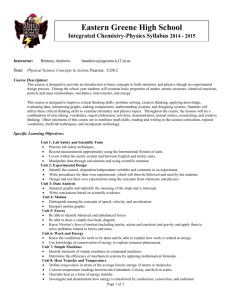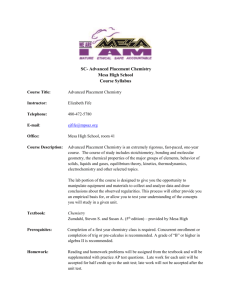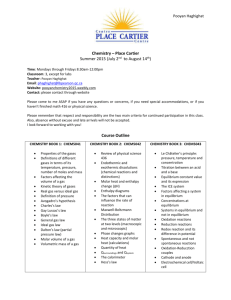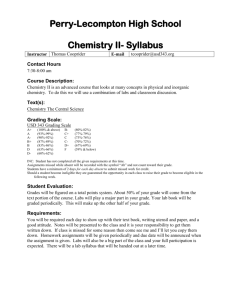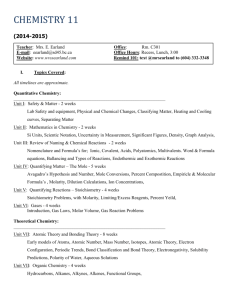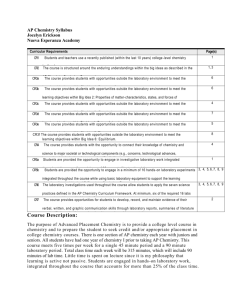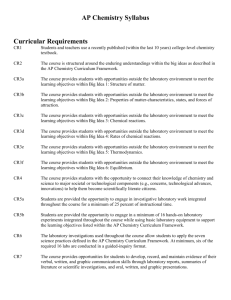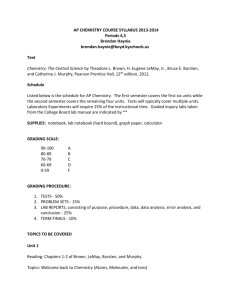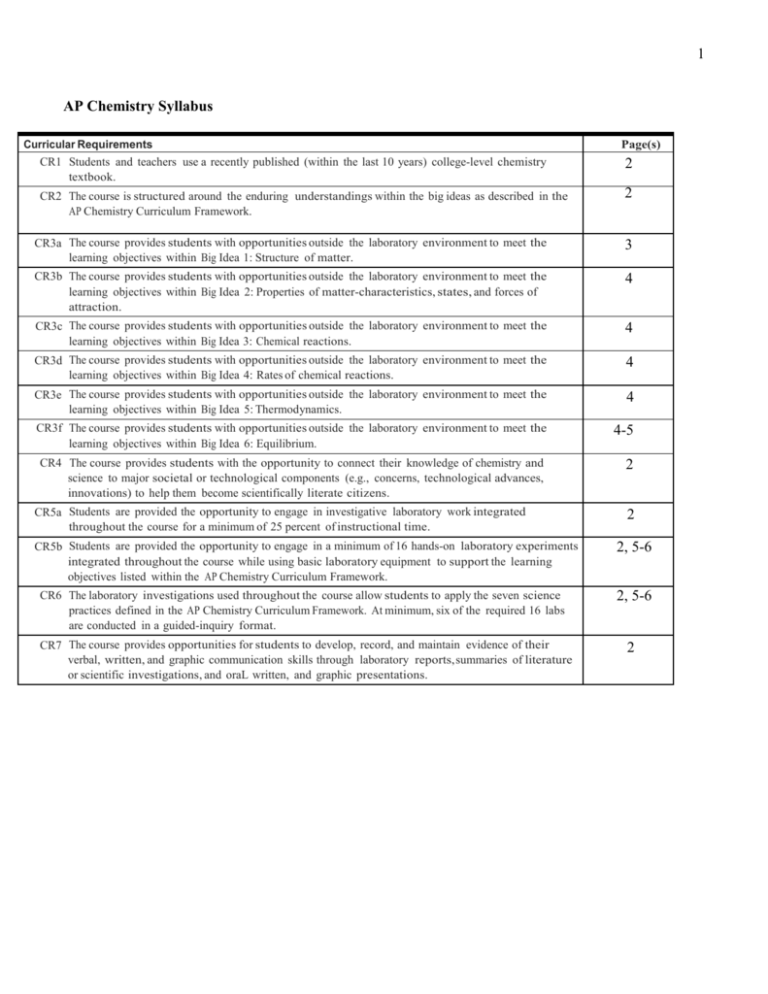
1
AP Chemistry Syllabus
Curricular Requirements
Page(s)
CR1 Students and teachers use a recently published (within the last 10 years) college-level chemistry
textbook.
2
CR2 The course is structured around the enduring understandings within the big ideas as described in the
AP Chemistry Curriculum Framework.
2
CR3a The course provides students with opportunities outside the laboratory environment to meet the
learning objectives within Big Idea 1: Structure of matter.
3
CR3b The course provides students with opportunities outside the laboratory environment to meet the
learning objectives within Big Idea 2: Properties of matter-characteristics, states, and forces of
attraction.
4
CR3c The course provides students with opportunities outside the laboratory environment to meet the
learning objectives within Big Idea 3: Chemical reactions.
4
CR3d The course provides students with opportunities outside the laboratory environment to meet the
learning objectives within Big Idea 4: Rates of chemical reactions.
4
CR3e The course provides students with opportunities outside the laboratory environment to meet the
learning objectives within Big Idea 5: Thermodynamics.
4
CR3f The course provides students with opportunities outside the laboratory environment to meet the
learning objectives within Big Idea 6: Equilibrium.
4-5
CR4 The course provides students with the opportunity to connect their knowledge of chemistry and
science to major societal or technological components (e.g., concerns, technological advances,
innovations) to help them become scientifically literate citizens.
2
CR5a Students are provided the opportunity to engage in investigative laboratory work integrated
throughout the course for a minimum of 25 percent of instructional time.
CR5b Students are provided the opportunity to engage in a minimum of 16 hands-on laboratory experiments
integrated throughout the course while using basic laboratory equipment to support the learning
objectives listed within the AP Chemistry Curriculum Framework.
CR6 The laboratory investigations used throughout the course allow students to apply the seven science
practices defined in the AP Chemistry Curriculum Framework. At minimum, six of the required 16 labs
are conducted in a guided-inquiry format.
CR7 The course provides opportunities for students to develop, record, and maintain evidence of their
verbal, written, and graphic communication skills through laboratory reports, summaries of literature
or scientific investigations, and oraL written, and graphic presentations.
2
2, 5-6
2, 5-6
2
2
Overview:
The purpose of the class is to provide a college-level course in Chemistry and to prepare the
student to seek credit and/or appropriate placement in college Chemistry courses. This course is
structured around the six big ideas articulated in the AP Chemistry curriculum framework provided by the
College Board. [CR2] All students are required to have successfully completed a year of Honors or New
York State Regents Chemistry before taking the AP class. The class is designed to build on, rather than
repeat, the prior work.
From the start of the school year up to the AP exam administration, the course meets the
equivalent of 9 42 minute periods per week. This includes a 4 period meeting on Wednesdays, which is
where the labs are scheduled. 16 labs are accomplished by running a lab every other week, which in
performance time alone would be 22 % of our total time. Periods of discussion and preparation before
and/or after the labs push our lab component to well over 25 % of our total time.
Topics are covered with class discussion based on textbook readings supplemented with my own
handouts and practice problems from various sources. All students and I own and use a copy of the class
text, which was published in 2012 [CR1].
Students engage in hands-on laboratory work, integrated throughout the course that accounts for
25% of the class time, as stated above. [CR5a] Labs develop conceptual and practical understanding of
content knowledge, while giving experience with inquiry and the seven science practices. At least six labs
utilize inquiry format [CR6].
Labs form a foundation for student understanding of the chemical principles discussed in lectures
but are also chosen to reflect the diversity of lab work generally completed in a first year course. Students
generally work with a partner to plan and carry out experiments. Most labs utilize traditional equipment
and measuring devices; a few utilize probeware and data collection software. [CR5b]
All students keep an electronic laboratory notebook on their tablet computer. Lab reports are
generally NOT individual, but done with the partner, or in some cases, developed by a team of four or
more students. (See "Group Lab Reports, page 10 of AP Chemistry Lab Manual) Lab reports tend to be
brief, including a general procedural description, all raw data, results, graphs, tables, and error analysis.
[CR7, SP1 thru 7]. A list of laboratories is included below.
Practical applications and ramifications are brought up throughout the course. For example, the
issue of fracking to extract methane is very much relevant in New York State. Students calculate the
energy production per mole of carbon dioxide produced by various fossil fuels, and conclude that methane
is the most environmentally desirable of the available choices [CR4 relating to Essential knowledge 5.C.2, g:"the use of such tables to compare related reactions"
A student’s grade is a weighted average of test scores (75%) and labs (25%).
Text
Brown, Theodore L., et.al., Chemistry: The Central Science – 12th ed. Pearson Prentice Hall 2012.
Course outline:
3
Unit
Chapters in Brown et al.
1
1. Introduction: Matter and
Measurement
2. Atoms, Molecules, and Ions
3. Stoichiometry: Calculations with
Chemical Formulas and Equations
4. Aqueous Reactions and Solution
Stoichiometry
6. Electronic Structure of Atoms
7. Periodic Properties of Elements
8. Basic Concepts of Chemical
Bonding
9. Molecular Geometry and Bonding
Theories
Supplementary material on
spectroscopy
10. Gases
11. Intermolecular Forces and Liquids
and Solids
12. Solids and Modern materials
(parts)
13. Properties of Solutions
14. Chemical Kinetics
15. Chemical Equilibrium
2
3
4
5
6
7
8
Big
Ideas
1, 3
Learning Objectives
1.1-1.4; 1.13-1.14;1.17-1.20
3.1-3.6; 3.8-3.10
1
1.5-1.10; 1.12
1, 2,
5
1.11; 1.15
2.1; 2.17-2.18; 2.21-2.22
5.1-5.2
2, 5
2.3-2.16; 2.19-2.20; 2.23-2.32
5.2; 5.6; 5.9-5.10
1, 4,
6
1.16;
4.1-4.9
6.1-6.10
16. Acid-Base Equilibria
17. Additional Aspects of Aqueous
Equilibria
5. Thermochemistry
19. Thermodynamics
2, 3,
6
2.2
3.7
6.11-6.24
3, 5,
6
3.11
5.3-5.8; 5.12-5.15; 5.17-5.18
6.25
20. Electrochemistry
3
3.12-3.13
Examples of activities for [CR3]
Learning objective 1.20 The student can design, and/or interpret data from, an experiment that uses titration to determine the concentration
of an analyte in a solution.
Students are given practice problems in class and in homework in which they are asked to calculate the
molarity of an unknown solution based on volumes (of both solutions) and molarity (of only one solution)
involved in a titration, including acid-base and redox types. In addition, students practice deriving the
same information from the pH profiles of acid-base titrations. [CR3a]
Learning objective 2.26 Students can use the electron sea model of metallic bonding to predict or make claims about the macroscopic
properties of metals or alloys.
4
Learning objective 2.27 The student can create a representation of a metallic solid that shows essential characteristics of the structure and
interactions present in the substance.
Learning objective 2.28 The student is able to explain a representation that connects properties of a metallic solid to its structural attributes
and to the interactions present at the atomic level.
After viewing several demonstrations about the properties of tin (melting, malleability, ductility, workhardening, electrical conductivity, thermal conductivity), students draw and justify particle diagrams of
the metal that account for these various properties using the electron-sea model of metallic bonding.
[CR3b]
Learning objective 3.11 The student is able to interpret observations regarding macroscopic energy changes associated with a reaction or
process to generate a relevant symbolic and/or graphical representation of the energy changes.
Students are instructed in several representations of energy storage and energy change, including reactionenergy plots, thermochemical equations, and storage plots (which show, qualitatively, the changes in
energy stored in a system as potential energy related to bonding, potential energy related to phase, and
thermal energy, as well as the overall gain or loss of energy by the system during a change). Throughout
the course, students are asked to use these different representations to demonstrate their understanding of
energy changes in a variety of contexts, including reading and homework, as well as some labs. [CR3c]
Learning objective 4.2 The student is able to analyze concentration vs. time data to determine the rate law for a zeroth-, first-, or secondorder reaction.
Students are presented time concentration vs. time data for a variety of different reactions, including
zeroth, 1st, and 2nd order examples. They learn to graph the data on their calculators or tablets, including
ln and reciprocal transformations. They learn to evaluate the graphs to determine the correct rate law, and
to determine or estimate the rate constant from the graphs. [CR3d]
Learning objective 5.2 The student is able to relate temperature to the motions of particles, either via particulate representations, such as
drawings of particles with arrows indicating velocities, and/or via representations of average kinetic energy and distribution of kinetic
energies of the particles, such as plots of the Maxwell-Boltzmann distribution.
After viewing a demonstration involving a "shaking platform" model of gas molecules of different masses
at different "temperatures" (speed of shaking), students engage in a discussion about the contributions of
mass and particle velocity to kinetic energy, and the relationship of average kinetic energy to temperature.
Students appreciate that even at a given temperature, molecules of the same mass can have different
instantaneous speeds. This leads to the idea of a speed or kinetic energy distribution in the population,
represented by the Maxwell-Boltzmann distribution. Students make particle drawings representing the
same gas at different temperatures. [CR3e]
Learning objective 6.3 The student can connect kinetics to equilibrium by using reasoning about equilibrium, such as Le Chatelier’s principle,
to infer the relative rates of the forward and reverse reactions.
In the kinetics unit, students learn that reactions tend to slow down as reactants are depleted. At the start
of the equilibrium unit, we extend that understanding to a situation where the reverse reaction is also
possible. Students work through an example (on paper) in which the rates are initially different. They
evaluate whether reactants undergo depletion while products increase, or products are depleted while
reactants increase, considering the net effect of the two directions of reaction. We then discuss how the
changes in concentration affect the rates in each direction. Students prepare plots of both concentration
over time, and rates over time. Students learn that in any such situation, the faster direction inevitably
slows down and the slower direction inevitably speeds up, and these trends continue until the rates are the
same, which is the condition of equilibrium. [CR3f]
5
List of laboratories:
Title and description
Use of physical properties in identifying matter.
Students construct a method of distinguishing several metals and some
pure liquids based on physical properties only. ( density is the desired
method, but no instructions are provided)
GRAVIMETRIC ANALYSIS OF CHLORIDE
Students determine the percentage of MgCl2 in a mixture with
NaNO3 by precipitation of chloride with AgNO3.
DETERMINATION OF SPECIFIC HEAT CAPACITY OF METALS.
Students determine the heat capacity of several different metals,
calculate MOLAR heat capacity, and draw conclusions about how
specific heat may be used to roughly determine atomic mass.
DETERMINATION OF THE MOLAR MASS OF CARBON DIOXIDE
Given a CO2 generator (acid and marble chips), students devise a method
to apply gas laws, and solve for molar mass.
carbonate mixture by thermal decomposition
MOLAR MASS OF GAS FROM A LIGHTER.
Students collect butane by water displacement, and calculate its molar
mass.
DETERMINATION OF MOLAR MASS OF MAGNESIUM. Students
collect the hydrogen produced when magnesium reacts with HCl. However,
because the pieces of Mg have very small masses, and we do not have
sufficiently precise balances to measure those masses within 10% accuracy,
students must devise a method that will overcome this difficulty.
inquiry SP
yes
2,3,4,5
Investigation 10 - AP Chemistry guided inquiry experiments
HOW LONG WILL THAT MARBLE STATUE LAST?
Experiment 12 - AP Chemistry guided inquiry experiments.
THE HAND WARMER DESIGN CHALLENGE.
Students compare the heat of solution of several different solutes.
HYDROGEN PEROXIDE DECOMPOSITION
Students determine the rate law for the iodide catalyzed
decomposition using the method of initial rates
STANDARDIZATION OF NAOH
Students dilute a stock solution of NaOH to a desired concentration,
prepare a solution of a primary standard, and determine the molarity of the
NaOH precisely.
DETERMINATION OF THE EQUIVALENT MASS OF A SOLID ACID.
Students determine the equivalent mass of a solid acid, using the
standardized solutions prepared in the previous experiment.
DETERMINATION OF THE % ACETIC ACID IN WHITE VINEGAR.
Students use their standardized base to find the % acetic acid. They devise
their own procedure entirely.
LET'S MAKE A BUFFER.
Students prepare a buffer of assigned pH , calculate its composition
unit
1
1,2,3
1
1,2,4,5,6,7
7
1,2,3,4,5,7
4
1,2,3,4
4
YES
1,2,3,4,5
1,4
yes
1,2,3,4,5,6,7 5
yes
1,2,3,4,5,6,7 7
yes
1,2,3,4,5,6,7 5
yes
yes
2,4,5,6
6
2,4,5,6
6
2,4,5,6
6
12,3,4,5,7
6
6
from experimental data, and assess its ability to resist pH change,
when challenged, compared to an unbuffered solution
HEAT OF NEUTRALIZATION
Students determine the heat of neutralization for various acid-base
combinations, and explain similarities and differences in the data
ELECTROLYSIS ANALYSIS
Students determine the rules for what happens at each electrode
during electrolysis of aqueous salt solutions
BEER'S LAW.
Students use colorimeters to determine the concentration of a given solution
of nickel (II) nitrate.
WHAT'S IN THOSE BOTTLES?
yes
Students must use their knowledge of acid-base behavior, solubility and
help from the Internet to distinguish among nine aqueous solutions, A
through I, knowing that they contain hydrochloric, acetic, sulfuric and
nitric acids, sodium, calcium, barium and potassium hydroxides, and
ammonia. (Usually performed after the AP exam)
QUALITATIVE ANALYSIS. (post AP exam)
Determination of the identity of an unknown solid salt.
1,2,3,4,5,6,7 6,7
1,3,5,6,7
8
1,2,4,5
1
1,2,3,4,5,7
7


